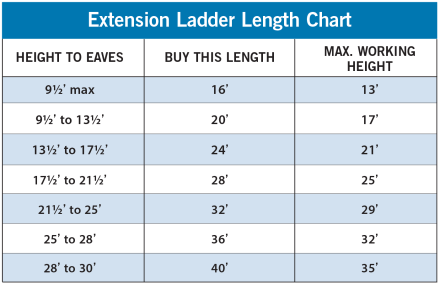Many simple chores around the house require a ladder. Because many homes in the city feature high ceilings, even simple tasks such as changing a light bulb might require a ladder to perform safely. A sturdy ladder is a worthwhile investment, and it will come in handy for many jobs in the home.
The three basic types of ladders are extension (straight), step, and step-extension. Ladders are rated by load capacity into household, commercial, and industrial grades. Ladder rungs are either flat, round, or D-shaped. The minimum size considered acceptable for round rungs is 1¼”, or 1½” for D-rungs. To ensure safety, rungs are required to be capable of carrying a much higher load than the rated load for the entire ladder.
CONSIDERATIONS WHEN CHOOSING A LADDER
Type of activity involved: The type of activity dictates which type of ladder you’ll need. Use a stepladder for interior painting, drywalling, spackling, and wallpapering. Stepladders include stepstools and platform ladders, generally for home or light commercial use. Stepladders are self-supporting and may include a pail hook or shelf. Extension ladders are best for painting exteriors, cleaning gutters, replacing shutters and siding, etc.
Demands of the application: Make sure the ladder is suitable for the physical demands of the application. The rated load capacity must exceed the maximum aggregate weight of the user along with his or her clothing and tools. Duty ratings are also color coded. Look for the proper duty ratings to match the highest level of use.
Height the ladder must reach: For a climber to work from a safe position, the ladder’s top should extend about 3 feet above the working surface when in use. Stepladders should be high enough for the user not to have to stand above the second step from the top. On extension ladders, stand no more than four rungs from the top.

Basic material: The most common ladder materials are wood, aluminum, and fiberglass. Wood ladders are nonconductive when clean and dry. Wood also provides a natural firm grip for feet and hands. However, wood tends to be heavy and is vulnerable to moisture and rot.
Aluminum is lightweight and strong, but does conduct electricity; aluminum ladders should never be used when working near energized electrical lines.
Fiberglass offers a blend of desirable qualities. It is nonconductive and strong — and an excellent choice for a variety of circumstances.
LADDER SAFETY TIPS
Do:
- Learn the proper methods for working with a ladder
- Keep your ladders well-maintained (for wood, treat with a wood preservative that leaves a clear surface)
- Choose duty ratings to match the highest level of use
Don’t:
- Use or repair a bent or damaged ladder
- Test a ladder by jumping on it
- Use a ladder on slippery surfaces or uneven ground
- Place ladder feet on power cords or come in contact with electrical current or power lines
- Climb down a ladder with your back to the ladder or carrying a load in your arms
- Overreach, lean to one side or stand on one foot
- Hurry or skip steps when getting on or off the ladder
- Leave a ladder unattended
- Position the ladder where it blocks foot traffic or where it could be bumped by a door
- Place the ladder on boxes, chairs, furniture, or other moveable object to try to climb higher
- Climb from one ladder to another or try to move a ladder while on it
- Climb a ladder when ill or using drugs or alcohol
- Drop or throw ladders
- Paint a wooden ladder (paint hides damage and can create a slippery surface for climbing)





